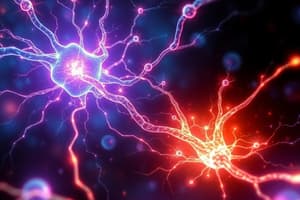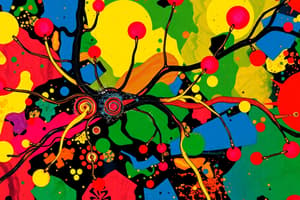Podcast
Questions and Answers
What is the primary function of voltage-gated calcium channels in nerve terminals?
What is the primary function of voltage-gated calcium channels in nerve terminals?
- To inhibit the release of acetylcholine
- To facilitate the diffusion of Ca2+ into the nerve terminal (correct)
- To regulate the activity of acetylcholine receptors
- To directly stimulate muscle contraction
What is the location of acetylcholine receptors in muscle fibers?
What is the location of acetylcholine receptors in muscle fibers?
- In the cytoplasm of the muscle fiber
- In the synaptic space
- On the surface of the nerve terminal
- In the muscle fiber membrane, below the dense bar areas (correct)
What is the process by which acetylcholine is released from synaptic vesicles into the synaptic space?
What is the process by which acetylcholine is released from synaptic vesicles into the synaptic space?
- Diffusion
- Endocytosis
- Exocytosis (correct)
- Osmosis
What is the effect of Ca2+ on acetylcholine vesicles in the nerve terminal?
What is the effect of Ca2+ on acetylcholine vesicles in the nerve terminal?
What is the approximate number of synaptic vesicles in the terminals of a single end plate?
What is the approximate number of synaptic vesicles in the terminals of a single end plate?
What is the function of linear dense bars in the neural membrane?
What is the function of linear dense bars in the neural membrane?
What is the result of the sudden influx of sodium ions into the muscle fiber when the acetylcholine channels open?
What is the result of the sudden influx of sodium ions into the muscle fiber when the acetylcholine channels open?
What is the minimum increase in membrane potential required to initiate an action potential in the muscle fiber?
What is the minimum increase in membrane potential required to initiate an action potential in the muscle fiber?
What is the primary mechanism by which the effect of acetylcholine binding is terminated?
What is the primary mechanism by which the effect of acetylcholine binding is terminated?
What is the result of stimulating the nerve fiber at rates greater than 100 times/second for several minutes?
What is the result of stimulating the nerve fiber at rates greater than 100 times/second for several minutes?
What is the primary function of acetylcholinesterase in the synaptic cleft?
What is the primary function of acetylcholinesterase in the synaptic cleft?
What is the name of the local potential created when the acetylcholine channels open?
What is the name of the local potential created when the acetylcholine channels open?
What is the primary reason for the larger influx of sodium ions compared to potassium ions through the acetylcholine channel?
What is the primary reason for the larger influx of sodium ions compared to potassium ions through the acetylcholine channel?
What is the primary effect of acetylcholine binding to its receptors on the muscle fiber membrane?
What is the primary effect of acetylcholine binding to its receptors on the muscle fiber membrane?
What is the outcome of the local positive potential change inside the muscle fiber membrane, also known as the end plate potential?
What is the outcome of the local positive potential change inside the muscle fiber membrane, also known as the end plate potential?
Which ions are repelled by the negative charges in the mouth of the acetylcholine channel?
Which ions are repelled by the negative charges in the mouth of the acetylcholine channel?
What is the requirement for the acetylcholine channel to open and allow ions to pass through?
What is the requirement for the acetylcholine channel to open and allow ions to pass through?
What is the purpose of the negative potential on the inside of the muscle membrane?
What is the purpose of the negative potential on the inside of the muscle membrane?
Flashcards are hidden until you start studying
Study Notes
Voltage-Gated Calcium Channels
- Primary function: Facilitate the influx of Ca2+ ions into nerve terminals, triggering the release of neurotransmitters.
Acetylcholine Receptors
- Location: Distributed on the postsynaptic membrane of muscle fibers, specifically within the motor end plate region.
Acetylcholine Release
- Process: Acetylcholine is released from synaptic vesicles into the synaptic space via exocytosis, triggered by increased intracellular calcium levels.
Calcium Ions and Acetylcholine Vesicles
- Effect of Ca2+: Influx of Ca2+ ions plays a crucial role in stimulating synaptic vesicles to fuse with the presynaptic membrane, facilitating neurotransmitter release.
Synaptic Vesicles in End Plate
- Count: Approximately 100-300 synaptic vesicles are present in the terminals of a single end plate.
Linear Dense Bars
- Function: Serve as anchoring sites for synaptic vesicles, stabilizing their position in the presynaptic membrane.
Sodium Ion Influx
- Result: Sudden influx of sodium ions when acetylcholine channels open causes depolarization of the muscle fiber membrane, leading to muscle contraction.
Action Potential Threshold
- Minimum potential increase: Around -55 mV is required to initiate an action potential in the muscle fiber.
Termination of Acetylcholine Effect
- Mechanism: The primary means of terminating acetylcholine's action is through enzymatic breakdown by acetylcholinesterase.
High-Frequency Nerve Stimulation
- Result: Stimulating the nerve fiber at rates greater than 100 times/second leads to sequential release of acetylcholine and potential exhaustion of synaptic vesicle pools.
Acetylcholinesterase
- Primary function: Breaks down acetylcholine in the synaptic cleft, preventing prolonged activation of acetylcholine receptors and ensuring quick signal termination.
Local Potential
- Name: End plate potential is the local depolarization generated when acetylcholine channels open.
Sodium vs. Potassium Ion Influx
- Primary reason: The channels are more permeable to sodium ions due to the electrochemical gradient, resulting in a larger influx compared to potassium ions.
Effects of Acetylcholine Binding
- Primary effect: Results in depolarization of the muscle fiber membrane, which contributes to muscle contraction.
End Plate Potential Outcome
- Result: The local positive potential change leads to the initiation of an action potential that propagates along the muscle fiber.
Ion Repulsion
- Repelled ions: Negative charges in the mouth of the acetylcholine channel repel Ca2+ ions while allowing Na+ ions to pass through more readily.
Acetylcholine Channel Opening Requirement
- Requirement: The binding of acetylcholine to its receptor is essential for the channel to open and permit ion flux.
Muscle Membrane Negative Potential
- Purpose: The negative potential inside the muscle membrane creates an electrochemical gradient, essential for action potential generation and restoration of resting membrane potential.
Studying That Suits You
Use AI to generate personalized quizzes and flashcards to suit your learning preferences.




